List of birds of Cyprus
This is a list of the bird species recorded in Cyprus. The avifauna of Cyprus include a total of 414 species. Of these, 22 species are globally threatened.
This list's taxonomic treatment (designation and sequence of orders, families and species) and nomenclature (common and scientific names) follow the conventions of The Clements Checklist of Birds of the World, 2019 edition. The family accounts at the beginning of each heading reflect this taxonomy, as do the species counts found in each family account. Introduced and accidental species are included in the total counts for Cyprus.
The following tags have been used to highlight several categories. The commonly occurring native species do not fall into any of these categories.
- (A) Accidental - a species that rarely or accidentally occurs in Cyprus
- (Ex) Extirpated - a species no longer found in Cyprus but found elsewhere
Ducks, geese, and waterfowl
.jpg)
_at_Sylvan_Heights.jpg)
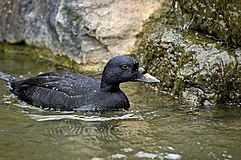
Order: Anseriformes Family: Anatidae
Anatidae includes the ducks and most duck-like waterfowl, such as geese and swans. These birds are adapted to an aquatic existence with webbed feet, bills which are flattened to a greater or lesser extent, and feathers that are excellent at shedding water due to special oils.
- Graylag goose, Anser anser
- Greater white-fronted goose, Anser albifrons
- Lesser white-fronted goose, Anser erythropus (A)
- Brant, Branta bernicla (A)
- Red-breasted goose, Branta ruficollis (A)
- Mute swan, Cygnus olor (A)
- Tundra swan, Cygnus columbianus (A)
- Whooper swan, Cygnus cygnus (A)
- Egyptian goose, Alopochen aegyptiacus (A)
- Ruddy shelduck, Tadorna ferruginea
- Common shelduck, Tadorna tadorna
- Garganey, Spatula querquedula
- Northern shoveler, Spatula clypeata
- Gadwall, Mareca strepera
- Eurasian wigeon, Mareca penelope
- Mallard, Anas platyrhynchos
- Northern pintail, Anas acute
- Green-winged teal, Anas crecca
- Marbled teal, Marmaronetta angustirostris (A)
- Red-crested pochard, Netta rufina
- Common pochard, Aythya ferina
- Ferruginous duck, Aythya nyroca
- Tufted duck, Aythya fuligula
- Greater scaup, Aythya marila (A)
- Common scoter, Melanitta nigra (A)
- Common goldeneye, Bucephala clangula (A)
- Smew, Mergellus albellus (A)
- Common merganser, Mergus merganser (A)
- Red-breasted merganser, Mergus serrator (A)
- Ruddy duck, Oxyura jamaicensis (A)
- White-headed duck, Oxyura leucocephala (A)
Pheasants, grouse, and allies
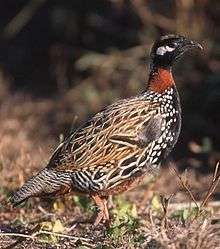
Order: Galliformes Family: Phasianidae
Phasianidae consists of the pheasants and their allies. These are terrestrial species, variable in size but generally plump with broad relatively short wings. Many species are gamebirds or have been domesticated as a food source for humans.
- Common quail, Coturnix coturnix
- Chukar, Alectoris chukar
- Black francolin, Francolinus francolinus
- Ring-necked pheasant, Phasianus colchicus
Flamingos
Order: Phoenicopteriformes Family: Phoenicopteridae
Flamingos (genus Phoenicopterus monotypic in family Phoenicopteridae) are gregarious wading birds, usually 3ÔÇô5 feet in height, found in both the Western and Eastern Hemispheres. Flamingos filter-feed on shellfish and algae. Their oddly shaped beaks are specially adapted to separate mud and silt from the food they consume and, uniquely, are used upside-down.
- Greater flamingo, Phoenicopterus roseus
- Lesser flamingo, Phoeniconaias minor (A)
Grebes
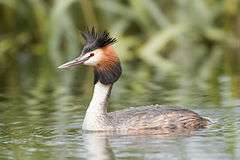
Order: Podicipediformes Family: Podicipedidae
Grebes are small to medium-large freshwater diving birds. They have lobed toes and are excellent swimmers and divers. However, they have their feet placed far back on the body, making them quite ungainly on land.
- Little grebe, Tachybaptus ruficollis
- Horned grebe, Podiceps auritus (A)
- Red-necked grebe, Podiceps grisegena (A)
- Great crested grebe, Podiceps cristatus
- Eared grebe, Podiceps nigricollis
Pigeons and doves
Order: Columbiformes Family: Columbidae
Pigeons and doves are stout-bodied birds with short necks and short slender bills with a fleshy cere.
- Rock pigeon, Columba livia
- Stock dove, Columba oenas (A)
- Common wood-pigeon, Columba palumbus
- European turtle-dove, Streptopelia turtur
- Oriental turtle-dove, Streptopelia orientalis (A)
- Eurasian collared-dove, Streptopelia decaocto RB
- Laughing dove, Spilopelia senegalensis (A)
- Namaqua dove, Oena capensis (A)
Sandgrouse
Order: Pterocliformes Family: Pteroclidae
Sandgrouse have small, pigeon-like heads and necks and sturdy compact bodies. The adults are sexually dimorphic with the males being slightly larger and more brightly colored than the females. They have eleven strong primary feathers and long pointed wings giving them a fast direct flight. The muscles of the wings are powerful and the birds are capable of rapid take off and sustained flight. There is a dense layer of under down which helps insulate the bird from extremes of heat and cold. The feathers of the belly are specially adapted for absorbing water and retaining it, allowing adults, particularly males, to carry water to chicks that may be many miles away from watering holes.
- Pin-tailed sandgrouse, Pterocles alchata (A)
- Black-bellied sandgrouse, Pterocles orientalis (A)
Bustards
Order: Otidiformes Family: Otididae
Bustards are large terrestrial birds mainly associated with dry open country and steppes in the Old World. They are omnivorous and nest on the ground. They walk steadily on strong legs and big toes, pecking for food as they go. They have long broad wings with "fingered" wingtips, and striking patterns in flight. Many have interesting mating displays.
- Great bustard, Otis tarda (A)
- MacQueen's bustard, Chlamydotis macqueenii (A)
- Little bustard, Tetrax tetrax (A)
Cuckoos
Order: Cuculiformes Family: Cuculidae
The family Cuculidae includes cuckoos, roadrunners and anis. These birds are of variable size with slender bodies, long tails and strong legs.
- Great spotted cuckoo, Clamator glandarius
- Dideric cuckoo, Chrysococcyx caprius (A)
- Common cuckoo, Cuculus canorus
Nightjars and allies
Order: Caprimulgiformes Family: Caprimulgidae
Nightjars are medium-sized nocturnal birds that usually nest on the ground. They have long wings, short legs and very short bills. Most have small feet, of little use for walking, and long pointed wings. Their soft plumage is cryptically coloured to resemble bark or leaves.
- Eurasian nightjar, Caprimulgus europaeus
Swifts
Order: Caprimulgiformes Family: Apodidae
The swifts are small birds which spend the majority of their lives flying. These birds have very short legs and never settle voluntarily on the ground, perching instead only on vertical surfaces. Many swifts have long swept-back wings which resemble a crescent or boomerang.
- Alpine swift, Apus melba
- Common swift, Apus apus
- Pallid swift, Apus pallidus
- Little swift, Apus affinis
Rails, gallinules and coots
Order: Gruiformes Family: Rallidae
.jpg)
Rallidae is a large family of small to medium-sized birds which includes the rails, crakes, coots and gallinules. The most typical family members occupy dense vegetation in damp environments near lakes, swamps or rivers. In general they are shy and secretive birds, making them difficult to observe. Most species have strong legs and long toes which are well adapted to soft uneven surfaces. They tend to have short, rounded wings and to be weak fliers.
- Water rail, Rallus aquaticus
- Corn crake, Crex crex (A)
- Spotted crake, Porzana porzana
- Eurasian moorhen, Gallinula chloropus
- Eurasian coot, Fulica atra
- Allen's gallinule, Porphyrio alleni (A)
- Gray-headed swamphen, Porphyrio poliocephalus (A)
- Little crake, Zapornia parva
- Baillon's crake, Zapornia pusilla (A)
Cranes
Order: Gruiformes Family: Gruidae
Cranes are large, long-legged and long-necked birds. Unlike the similar-looking but unrelated herons, cranes fly with necks outstretched, not pulled back. Most have elaborate and noisy courting displays or "dances".
- Demoiselle crane, Anthropoides virgo
- Common crane, Grus grus
Thick-knees
Order: Charadriiformes Family: Burhinidae
The thick-knees are a group of largely tropical waders in the family Burhinidae. They are found worldwide within the tropical zone, with some species also breeding in temperate Europe and Australia. They are medium to large waders with strong black or yellow-black bills, large yellow eyes and cryptic plumage. Despite being classed as waders, most species have a preference for arid or semi-arid habitats.
- Eurasian thick-knee, Burhinus oedicnemus
Stilts and avocets
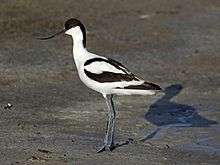
Order: Charadriiformes Family: Recurvirostridae
Recurvirostridae is a family of large wading birds, which includes the avocets and stilts. The avocets have long legs and long up-curved bills. The stilts have extremely long legs and long, thin, straight bills.
- Black-winged stilt, Himantopus himantopus
- Pied avocet, Recurvirostra avosetta
Oystercatchers
Order: Charadriiformes Family: Haematopodidae
The oystercatchers are large, obvious and noisy plover-like birds, with strong bills used for smashing or prising open molluscs.
- Eurasian oystercatcher, Haematopus ostralegus
Plovers and lapwings
Order: Charadriiformes Family: Charadriidae
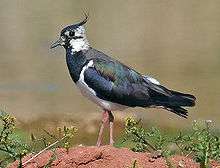
The family Charadriidae includes the plovers, dotterels and lapwings. They are small to medium-sized birds with compact bodies, short, thick necks and long, usually pointed, wings. They are found in open country worldwide, mostly in habitats near water.
- Black-bellied plover, Pluvialis squatarola
- European golden-plover, Pluvialis apricaria
- Pacific golden-plover, Pluvialis fulva (A)
- Northern lapwing, Vanellus vanellus
- Spur-winged lapwing, Vanellus spinosus
- Sociable lapwing, Vanellus gregarius (A)
- White-tailed lapwing, Vanellus leucurus (A)
- Greater sand-plover, Charadrius leschenaultii
- Caspian plover, Charadrius asiaticus (A)
- Kittlitz's plover, Charadrius pecuarius (A)
- Kentish plover, Charadrius alexandrinus
- Common ringed plover, Charadrius hiaticula
- Little ringed plover, Charadrius dubius
- Eurasian dotterel, Charadrius morinellus
Sandpipers and allies
Order: Charadriiformes Family: Scolopacidae
Scolopacidae is a large diverse family of small to medium-sized shorebirds including the sandpipers, curlews, godwits, shanks, tattlers, woodcocks, snipes, dowitchers and phalaropes. The majority of these species eat small invertebrates picked out of the mud or soil. Different lengths of legs and bills enable multiple species to feed in the same habitat, particularly on the coast, without direct competition for food.
- Whimbrel, Numenius phaeopus
- Slender-billed curlew, Numenius tenuirostris (A)
- Eurasian curlew, Numenius arquata
- Bar-tailed godwit, Limosa lapponica (A)
- Black-tailed godwit, Limosa limosa
- Ruddy turnstone, Arenaria interpres
- Red knot, Calidris canutus (A)
- Ruff, Calidris pugnax
- Broad-billed sandpiper, Calidris falcinellus (A)
- Curlew sandpiper, Calidris ferruginea
- Temminck's stint, Calidris temminckii
- Sanderling, Calidris alba
- Dunlin, Calidris alpina
- Baird's sandpiper, Calidris bairdii (A)
- Little stint, Calidris minuta
- Pectoral sandpiper, Calidris melanotos (A)
- Jack snipe, Lymnocryptes minimus
- Eurasian woodcock, Scolopax rusticola
- Great snipe, Gallinago media (A)
- Common snipe, Gallinago gallinago
- Terek sandpiper, Xenus cinereus (A)
- Red-necked phalarope, Phalaropus lobatus (A)
- Red phalarope, Phalaropus fulicarius (A)
- Common sandpiper, Actitis hypoleucos
- Green sandpiper, Tringa ochropus
- Spotted redshank, Tringa erythropus
- Common greenshank, Tringa nebularia
- Marsh sandpiper, Tringa stagnatilis
- Wood sandpiper, Tringa glareola
- Common redshank, Tringa totanus
Pratincoles and coursers
Order: Charadriiformes Family: Glareolidae
Pratincoles have short legs, very long pointed wings and long forked tails. Their most unusual feature for birds classed as waders is that they typically hunt their insect prey on the wing like swallows, although they can also feed on the ground. Their short bills are an adaptation to aerial feeding.
- Cream-colored courser, Cursorius cursor
- Collared pratincole, Glareola pratincola
- Oriental pratincole, Glareola maldivarum (A)
- Black-winged pratincole, Glareola nordmanni (A)
Skuas and jaegers
Order: Charadriiformes Family: Stercorariidae
Skuas are in general medium to large birds, typically with grey or brown plumage, often with white markings on the wings. They have longish bills with hooked tips, and webbed feet with sharp claws. They look like large dark gulls, but have a fleshy cere above the upper mandible. They are strong, acrobatic fliers.
- Pomarine jaeger, Stercorarius pomarinus (A)
- Parasitic jaeger, Stercorarius parasiticus (A)
Gulls, terns, and skimmers
Order: Charadriiformes Family: Laridae
Laridae is a family of medium to large seabirds and includes gulls, terns, kittiwakes and skimmers. Gulls are typically grey or white, often with black markings on the head or wings. They have stout, longish bills and webbed feet. Terns are a group of generally medium to large seabirds typically with grey or white plumage, often with black markings on the head. Most terns hunt fish by diving but some pick insects off the surface of fresh water. Terns are generally long-lived birds, with several species known to live in excess of 30 years.
- Black-legged kittiwake, Rissa tridactyla (A)
- Slender-billed gull, Chroicocephalus genei
- Black-headed gull, Chroicocephalus ridibundus
- Little gull, Hydrocoloeus minutus
- Franklin's gull, Leucophaeus pipixcan (A)
- Mediterranean gull, Ichthyaetus melanocephalus
- White-eyed gull, Ichthyaetus leucophthalmus (A)
- Pallas's gull, Ichthyaetus ichthyaetus (A)
- Audouin's gull, Ichthyaetus audouinii
- Mew gull, Larus canus
- Herring gull, Larus argentatus (A)
- Yellow-legged gull, Larus michahellis
- Caspian gull, Larus cachinnans
- Armenian gull, Larus armenicus
- Lesser black-backed gull, Larus fuscus
- Great black-backed gull, Larus marinus (A)
- Little tern, Sternula albifrons
- Gull-billed tern, Gelochelidon nilotica
- Caspian tern, Hydroprogne caspia (A)
- Black tern, Chlidonias niger
- White-winged tern, Chlidonias leucopterus
- Whiskered tern, Chlidonias hybrida
- Common tern, Sterna hirundo
- Arctic tern, Sterna paradisaea (A)
- Sandwich tern, Thalasseus sandvicensis
Loons
Order: Gaviiformes Family: Gaviidae
Loons are aquatic birds the size of a large duck, to which they are unrelated. Their plumage is largely grey or black, and they have spear-shaped bills. Loons swim well and fly adequately, but, because their legs are placed towards the rear of the body, are almost helpless on land.
- Red-throated loon, Gavia stellata (A)
- Arctic loon, Gavia arctica (A)
Northern storm-petrels
Order: Procellariiformes Family: Hydrobatidae
The northern storm-petrels are the smallest seabirds, relatives of the petrels, feeding on planktonic crustaceans and small fish picked from the surface, typically while hovering. The flight is fluttering and sometimes bat-like.
- European storm-petrel, Hydrobates pelagicus (A)
Shearwaters and petrels
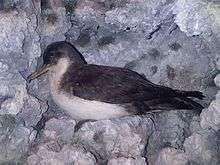
Order: Procellariiformes Family: Procellariidae
The procellariids are the main group of medium-sized "true petrels", characterised by united nostrils with medium septum, and a long outer functional primary.
- Cory's shearwater, Calonectris diomedea
- Yelkouan shearwater, Puffinus yelkouan
Storks
Order: Ciconiiformes Family: Ciconiidae
Storks are large, heavy, long-legged, long-necked wading birds with long stout bills and wide wingspans. They lack the powder down that other wading birds such as herons, spoonbills and ibises use to clean off fish slime. Storks lack a pharynx and are mute.
- Black stork, Ciconia nigra
- White stork, Ciconia ciconia
Boobies and gannets
Order: Suliformes Family: Sulidae
The sulids comprise the gannets and boobies. Both groups are medium-large coastal seabirds that plunge-dive for fish.
- Northern gannet, Morus bassanus (A)
Cormorants and shags
Order: Suliformes Family: Phalacrocoracidae
Cormorants are medium-to-large aquatic birds, usually with mainly dark plumage and areas of coloured skin on the face. The bill is long, thin and sharply hooked. Their feet are four-toed and webbed, a distinguishing feature among the order Pelecaniformes.
- Pygmy cormorant, Microcarbo pygmeus (A)
- Great cormorant, Phalacrocorax carbo
- European shag, Phalacrocorax aristotelis
Pelicans
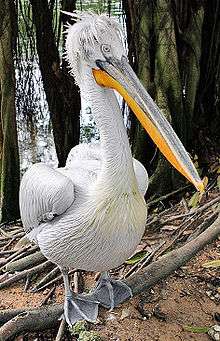
Order': Pelecaniformes Family: Pelecanidae
Pelicans are very large water birds with a distinctive pouch under their beak. Like other birds in the order Pelecaniformes, they have four webbed toes.
- Great white pelican, Pelecanus onocrotalus
- Dalmatian pelican, Pelecanus crispus (A)
Herons, egrets, and bitterns
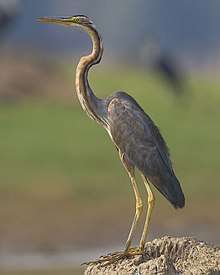
Order: Pelecaniformes Family: Ardeidae
The family Ardeidae contains the herons, egrets and bitterns. Herons and egrets are medium to large wading birds with long necks and legs. Bitterns tend to be shorter necked and more secretive. Members of Ardeidae fly with their necks retracted, unlike other long-necked birds such as storks, ibises and spoonbills.
- Great bittern, Botaurus stellaris
- Little bittern, Ixobrychus minutus
- Gray heron, Ardea cinerea
- Purple heron, Ardea purpurea
- Great egret, Ardea alba
- Little egret, Egretta garzetta
- Western reef-heron, Egretta gularis (A)
- Cattle egret, Bubulcus ibis
- Squacco heron, Ardeola ralloides
- Striated heron, Butorides striata (A)
- Black-crowned night-heron, Nycticorax nycticorax
Ibises and spoonbills
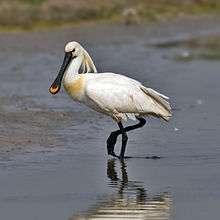
Order: Pelecaniformes Family: Threskiornithidae
Members of this family have long, broad wings, are strong fliers and, rather surprisingly, given their size and weight, very capable soarers. The body tends to be elongated, the neck more so, with rather long legs. The bill is also long, decurved in the case of the ibises, straight and distinctively flattened in the spoonbills.
- Glossy ibis, Plegadis falcinellus
- Eurasian spoonbill, Platalea leucorodia
Osprey
Order: Accipitriformes Family: Pandionidae
Pandionidae is a family of fish-eating birds of prey, possessing a very large, powerful hooked beak for tearing flesh from their prey, strong legs, powerful talons and keen eyesight. The family is monotypic.
- Osprey, Pandion haliaetus
Hawks, eagles, and kites
.jpg)
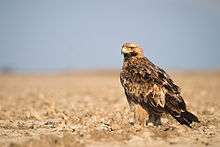
Order: Accipitriformes Family: Accipitridae
Accipitridae is a family of birds of prey, which includes eagles, hawks, kites, harriers and Old World vultures. These birds have very large powerful hooked beaks for tearing flesh from their prey, strong legs, powerful talons and keen eyesight.
- Black-winged kite, Elanus caeruleus (A)
- Bearded vulture, Gypaetus barbatus (A)
- Egyptian vulture, Neophron percnopterus
- European honey-buzzard, Pernis apivorus
- Oriental honey-buzzard, Pernis ptilorhynchus (A)
- Cinereous vulture, Aegypius monachus (A)
- Eurasian griffon, Gyps fulvus
- Bateleur, Terathopius ecaudatus (A)
- Short-toed snake-eagle, Circaetus gallicus (A)
- Lesser spotted eagle, Clanga pomarina (A)
- Greater spotted eagle, Clanga clanga (A)
- Booted eagle, Hieraaetus pennatus
- Imperial eagle, Aquila heliaca (A)
- Golden eagle, Aquila chrysaetos (A)
- Bonelli's eagle, Aquila fasciata
- Eurasian marsh-harrier, Circus aeruginosus
- Hen harrier, Circus cyaneus
- Pallid harrier, Circus macrourus
- Montagu's harrier, Circus pygargus
- Levant sparrowhawk, Accipiter brevipes (A)
- Eurasian sparrowhawk, Accipiter nisus
- Northern goshawk, Accipiter gentiles
- Red kite, Milvus milvus (A)
- Black kite, Milvus migrans
- White-tailed eagle, Haliaeetus albicilla (A)
- Rough-legged hawk, Buteo lagopus (A)
- Common buzzard, Buteo buteo
- Long-legged buzzard, Buteo rufinus
Barn-owls
Order: Strigiformes Family: Tytonidae
Barn owls are medium to large owls with large heads and characteristic heart-shaped faces. They have long strong legs with powerful talons.
- Barn owl, Tyto alba
Owls
Order: Strigiformes Family: Strigidae
Typical owls are small to large solitary nocturnal birds of prey. They have large forward-facing eyes and ears, a hawk-like beak and a conspicuous circle of feathers around each eye called a facial disk.
- Eurasian scops-owl, Otus scops
- Little owl, Athene noctua
- Long-eared owl, Asio otus
- Short-eared owl, Asio flammeus (A)
Hoopoes
Order: Upupiformes Family: Upupidae
This black, white and pink bird is quite unmistakable, especially in its erratic flight, which is like that of a giant butterfly. It is the only member of its family. The song is a trisyllabic oop-oop-oop, which gives rise to its English and scientific names.
- Eurasian hoopoe, Upupa epops
Kingfishers
Order: Coraciiformes Family: Alcedinidae
Kingfishers are medium-sized birds with large heads, long, pointed bills, short legs and stubby tails.
- Common kingfisher, Alcedo atthis
- White-throated kingfisher, Halcyon smyrnensis (A)
- Pied kingfisher, Ceryle rudis (A)
Bee-eaters
Order: Coraciiformes Family: Meropidae
The bee-eaters are a group of near passerine birds in the family Meropidae. Most species are found in Africa but others occur in southern Europe, Madagascar, Australia and New Guinea. They are characterised by richly coloured plumage, slender bodies and usually elongated central tail feathers. All are colourful and have long downturned bills and pointed wings, which give them a swallow-like appearance when seen from afar.
- Blue-cheeked bee-eater, Merops persicus
- European bee-eater, Merops apiaster
Rollers
Order: Coraciiformes Family: Coraciidae
Rollers resemble crows in size and build, but are more closely related to the kingfishers and bee-eaters. They share the colourful appearance of those groups with blues and browns predominating. The two inner front toes are connected, but the outer toe is not.
- European roller, Coracias garrulous
Woodpeckers
Order: Piciformes Family: Picidae
Woodpeckers are small to medium-sized birds with chisel-like beaks, short legs, stiff tails and long tongues used for capturing insects. Some species have feet with two toes pointing forward and two backward, while several species have only three toes. Many woodpeckers have the habit of tapping noisily on tree trunks with their beaks.
- Eurasian wryneck, Jynx torquilla
Falcons and caracaras
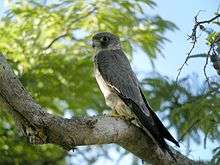
Order: Falconiformes Family: Falconidae
Falconidae is a family of diurnal birds of prey, notably the falcons and caracaras. They differ from hawks, eagles and kites in that they kill with their beaks instead of their talons.
- Lesser kestrel, Falco naumanni
- Eurasian kestrel, Falco tinnunculus
- Red-footed falcon, Falco vespertinus
- Amur falcon, Falco amurensis (A)
- Eleonora's falcon, Falco eleonorae
- Sooty falcon, Falco concolor (A)
- Merlin, Falco columbarius
- Eurasian hobby, Falco subbuteo
- Lanner falcon, Falco biarmicus (A)
- Saker falcon, Falco cherrug (A)
- Peregrine falcon, Falco peregrinus
Old world orioles
Order: Passeriformes Family: Oriolidae
The Old World orioles are colorful passerine birds. They are not related to the New World orioles.
- Eurasian golden oriole, Oriolus oriolus
Shrikes
Order: Passeriformes Family: Laniidae
Shrikes are passerine birds known for their habit of catching other birds and small animals and impaling the uneaten portions of their bodies on thorns. A typical shrike's beak is hooked, like a bird of prey.
- Red-backed shrike, Lanius collurio
- Red-tailed shrike, Lanius phoenicuroides (A)
- Isabelline shrike, Lanius isabellinus (A)
- Great gray shrike, Lanius excubitor (A)
- Lesser gray shrike, Lanius minor
- Masked shrike, Lanius nubicus
- Woodchat shrike, Lanius senator
Crows, jays, and magpies
Order: Passeriformes Family: Corvidae
The family Corvidae includes crows, ravens, jays, choughs, magpies, treepies, nutcrackers and ground jays. Corvids are above average in size among the Passeriformes, and some of the larger species show high levels of intelligence.
- Eurasian jay, Garrulus glandarius
- Eurasian magpie, Pica pica
- Eurasian jackdaw, Corvus monedula
- House crow, Corvus splendens (A)
- Rook, Corvus frugilegus (A)
- Hooded crow, Corvus cornix
- Brown-necked raven, Corvus ruficollis (A)
- Common raven, Corvus corax
Tits, chickadees, and titmice
Order: Passeriformes Family: Paridae
The Paridae are mainly small stocky woodland species with short stout bills. Some have crests. They are adaptable birds, with a mixed diet including seeds and insects.
- Coal tit, Periparus ater
- Eurasian blue tit, Cyanistes caeruleus (A)
- Great tit, Parus major
Penduline-tits
Order: Passeriformes Family: Remizidae
The penduline-tits are a group of small passerine birds related to the true tits. They are insectivores.
- Eurasian penduline-tit, Remiz pendulinus
Larks
Order: Passeriformes Family: Alaudidae
Larks are small terrestrial birds with often extravagant songs and display flights. Most larks are fairly dull in appearance. Their food is insects and seeds.
- Bar-tailed lark, Ammomanes cinctura (A)
- Desert lark, Ammomanes deserti (A)
- Horned lark, Eremophila alpestris (A)
- Temminck's lark, Eremophila bilopha (A)
- Greater short-toed lark, Calandrella brachydactyla
- Bimaculated lark, Melanocorypha bimaculata (A)
- Calandra lark, Melanocorypha calandra
- Dupont's lark, Chersophilus duponti (A)
- Dunn's lark, Eremalauda dunni (A)
- Lesser short-toed lark, Alaudala rufescens
- Wood lark, Lullula arborea
- Eurasian skylark, Alauda arvensis
- Crested lark, Galerida cristata
Bearded reedling
Order: Passeriformes Family: Panuridae
This species, the only one in its family, is found in reed beds throughout temperate Europe and Asia.
- Bearded reedling, Panurus biarmicus
Cisticolas and allies
Order: Passeriformes Family: Cisticolidae
The Cisticolidae are warblers found mainly in warmer southern regions of the Old World. They are generally very small birds of drab brown or gray appearance found in open country such as grassland or scrub.
- Graceful prinia, Prinia gracilis (A)
- Zitting cisticola, Cisticola juncidis
Reed warblers and allies
Order: Passeriformes Family: Acrocephalidae
The members of this family are usually rather large for "warblers". Most are rather plain olivaceous brown above with much yellow to beige below. They are usually found in open woodland, reedbeds, or tall grass. The family occurs mostly in southern to western Eurasia and surroundings, but it also ranges far into the Pacific, with some species in Africa.
- Eastern olivaceous warbler, Iduna pallida
- Upcher's warbler, Hippolais languida (A)
- Olive-tree warbler, Hippolais olivetorum (A)
- Icterine warbler, Hippolais icterina (A)
- Aquatic warbler, Acrocephalus paludicola (A)
- Moustached warbler, Acrocephalus melanopogon
- Sedge warbler, Acrocephalus schoenobaenus
- Paddyfield warbler, Acrocephalus agricola (A)
- Blyth's reed warbler, Acrocephalus dumetorum (A)
- Marsh warbler, Acrocephalus palustris (A)
- Eurasian reed warbler, Acrocephalus scirpaceus
- Basra reed warbler, Acrocephalus griseldis (A)
- Great reed warbler, Acrocephalus arundinaceus
Grassbirds and allies
Order: Passeriformes Family: Locustellidae
Locustellidae are a family of small insectivorous songbirds found mainly in Eurasia, Africa, and the Australian region. They are smallish birds with tails that are usually long and pointed, and tend to be drab brownish or buffy all over.
- River warbler, Locustella fluviatilis (A)
- Savi's warbler, Locustella luscinioides
- Common grasshopper-warbler, Locustella naevia (A)
Swallows
Order: Passeriformes Family: Hirundinidae
The family Hirundinidae is adapted to aerial feeding. They have a slender streamlined body, long pointed wings and a short bill with a wide gape. The feet are adapted to perching rather than walking, and the front toes are partially joined at the base.
- Plain martin, Riparia paludicola (A)
- Bank swallow, Riparia riparia
- Eurasian crag-martin, Ptyonoprogne rupestris
- Barn swallow, Hirundo rustica
- Red-rumped swallow, Cecropis daurica
- Common house-martin, Delichon urbicum'
Leaf warblers
Order: Passeriformes Family: Phylloscopidae
Leaf warblers are a family of small insectivorous birds found mostly in Eurasia and ranging into Wallacea and Africa. The species are of various sizes, often green-plumaged above and yellow below, or more subdued with greyish-green to greyish-brown colours.
- Wood warbler, Phylloscopus sibilatrix
- Eastern Bonelli's warbler, Phylloscopus orientalis
- Yellow-browed warbler, Phylloscopus inornatus (A)
- Hume's warbler, Phylloscopus humei (A)
- Dusky warbler, Phylloscopus fuscatus (A)
- Willow warbler, Phylloscopus trochilus
- Mountain chiffchaff, Phylloscopus sindianus (A)
- Common chiffchaff, Phylloscopus collybita
Bush warblers and allies
Order: Passeriformes Family: Scotocercidae
The members of this family are found throughout Africa, Asia, and Polynesia. Their taxonomy is in flux, and some authorities place some genera in other families.[1]
- Cetti's warbler, Cettia cetti
Sylviid warblers, parrotbills, and allies
Order: Passeriformes Family: Sylviidae
The family Sylviidae is a group of small insectivorous passerine birds. They mainly occur as breeding species, as the common name implies, in Europe, Asia and, to a lesser extent, Africa. Most are of generally undistinguished appearance, but many have distinctive songs.
- Eurasian blackcap, Sylvia atricapilla
- Garden warbler, Sylvia borin
- Asian desert warbler, Sylvia nana (A)
- Barred warbler, Sylvia nisoria
- Lesser whitethroat, Sylvia curruca
- Eastern Orphean warbler, Sylvia crassirostris
- Cyprus warbler, Sylvia melanothorax
- Menetries's warbler, Sylvia mystacea (A)
- Rüppell's warbler, Sylvia ruppeli
- Subalpine warbler, Sylvia cantillans
- Sardinian warbler, Sylvia melanocephala
- Greater whitethroat, Sylvia communis
- Spectacled warbler, Sylvia conspicillata
Kinglets
Order: Passeriformes Family: Regulidae
The kinglets, also called crests, are a small group of birds often included in the Old World warblers, but frequently given family status because they also resemble the titmice.
- Goldcrest, Regulus regulus
- Common firecrest, Regulus ignicapilla (A)
Wallcreeper
Order: Passeriformes Family: Tichodromidae
The wallcreeper is a small bird, with stunning crimson, gray and black plumage, related to the nuthatch family.
- Wallcreeper, Tichodroma muraria
Treecreepers
Order: Passeriformes Family: Certhiidae
Treecreepers are small woodland birds, brown above and white below. They have thin pointed down-curved bills, which they use to extricate insects from bark. They have stiff tail feathers, like woodpeckers, which they use to support themselves on vertical trees.
- Short-toed treecreeper, Certhia brachydactyla
Wrens
Order: Passeriformes Family: Troglodytidae
The wrens are mainly small and inconspicuous except for their loud songs. These birds have short wings and thin down-turned bills. Several species often hold their tails upright. All are insectivorous.
- Eurasian wren, Troglodytes troglodytes
Dippers
Order: Passeriformes Family: Cinclidae
Dippers are a group of perching birds whose habitat includes aquatic environments in the Americas, Europe and Asia. They are named for their bobbing or dipping movements.
- White-throated dipper, Cinclus cinclus (Ex)
Starlings
Order: Passeriformes Family: Sturnidae
Starlings are small to medium-sized passerine birds. Their flight is strong and direct and they are very gregarious. Their preferred habitat is fairly open country. They eat insects and fruit. Plumage is typically dark with a metallic sheen.
- European starling, Sturnus vulgaris
- Rosy starling, Pastor roseus (A)
Thrushes and allies
Order: Passeriformes Family: Turdidae
The thrushes are a group of passerine birds that occur mainly in the Old World. They are plump, soft plumaged, small to medium-sized insectivores or sometimes omnivores, often feeding on the ground. Many have attractive songs.
- Mistle thrush, Turdus viscivorus
- Song thrush, Turdus philomelos
- Redwing, Turdus iliacus
- Eurasian blackbird, Turdus merula
- Fieldfare, Turdus pilaris
- Ring ouzel, Turdus torquatus (A)
- Dusky thrush, Turdus eunomus (A)
- Naumann's thrush, Turdus naumanni (A)
Old-World flycatchers
Order: Passeriformes Family: Muscicapidae
Old World flycatchers are a large group of small passerine birds native to the Old World. They are mainly small arboreal insectivores. The appearance of these birds is highly varied, but they mostly have weak songs and harsh calls.
- Spotted flycatcher, Muscicapa striata
- Rufous-tailed scrub-robin, Cercotrichas galactotes
- European robin, Erithacus rubecula
- White-throated robin, Irania gutturalis (A)
- Thrush nightingale, Luscinia luscinia (A)
- Common nightingale, Luscinia megarhynchos
- Bluethroat, Luscinia svecica
- Red-flanked bluetail, Tarsiger cyanurus (A)
- Red-breasted flycatcher, Ficedula parva
- Semicollared flycatcher, Ficedula semitorquata
- European pied flycatcher, Ficedula hypoleuca
- Collared flycatcher, Ficedula albicollis
- Common redstart, Phoenicurus phoenicurus
- Black redstart, Phoenicurus ochruros
- Rufous-tailed rock-thrush, Monticola saxatilis (A)
- Blue rock-thrush, Monticola solitarius
- Whinchat, Saxicola rubetra
- European stonechat, Saxicola rubicola
- Siberian stonechat, Saxicola maurus (A)
- Pied bushchat, Saxicola caprata (A)
- Northern wheatear, Oenanthe oenanthe
- Isabelline wheatear, Oenanthe isabellina
- Hooded wheatear, Oenanthe monacha (A)
- Desert wheatear, Oenanthe deserti
- Pied wheatear, Oenanthe pleschanka (A)
- Black-eared wheatear, Oenanthe hispanica
- Cyprus wheatear, Oenanthe cypriaca
- White-crowned wheatear, Oenanthe leucopyga (A)
- Finsch's wheatear, Oenanthe finschii (A)
- Mourning wheatear, Oenanthe lugens (A)
- Kurdish wheatear, Oenanthe xanthoprymna (A)
Waxwings
Order: Passeriformes Family: Bombycillidae
The waxwings are a group of birds with soft silky plumage and unique red tips to some of the wing feathers. In the Bohemian and cedar waxwings, these tips look like sealing wax and give the group its name. These are arboreal birds of northern forests. They live on insects in summer and berries in winter.
- Bohemian waxwing, Bombycilla garrulus (A)
Hypocolius
Order: Passeriformes Family: Hypocoliidae
The grey hypocolius is a small Middle Eastern bird with the shape and soft plumage of a waxwing. They are mainly a uniform grey colour except the males have a black triangular mask around their eyes.
- Hypocolius, Hypocolius ampelinus (A)
Accentors
Order: Passeriformes Family: Prunellidae
The accentors are in the only bird family, Prunellidae, which is completely endemic to the Palearctic. They are small, fairly drab species superficially similar to sparrows.
- Dunnock, Prunella modularis
Old World sparrows
Order: Passeriformes Family: Passeridae
Old World sparrows are small passerine birds. In general, sparrows tend to be small, plump, brown or gray birds with short tails and short powerful beaks. Sparrows are seed eaters, but they also consume small insects.
- House sparrow, Passer domesticus
- Spanish sparrow, Passer hispaniolensis
- Dead Sea sparrow, Passer moabiticus (A)
- Eurasian tree sparrow, Passer montanus (A)
- Rock sparrow, Petronia petronia (A)
- Pale rockfinch, Carpospiza brachydactyla (A)
- White-winged snowfinch, Montifringilla nivalis (A)
Wagtails and pipits
Order: Passeriformes Family: Motacillidae
Motacillidae is a family of small passerine birds with medium to long tails. They include the wagtails, longclaws and pipits. They are slender, ground feeding insectivores of open country
- Gray wagtail, Motacilla cinerea
- Western yellow wagtail, Motacilla flava
- Eastern yellow wagtail, Motacilla tschutschensis (A)
- Citrine wagtail, Motacilla citreola
- White wagtail, Motacilla alba
- Richard's pipit, Anthus richardi (A)
- Long-billed pipit, Anthus similis (A)
- Blyth's pipit, Anthus godlewskii (A)
- Tawny pipit, Anthus campestris
- Meadow pipit, Anthus pratensis
- Tree pipit, Anthus trivialis
- Olive-backed pipit, Anthus hodgsoni (A)
- Red-throated pipit, Anthus cervinus
- Water pipit, Anthus spinoletta (A)
- American pipit, Anthus rubescens (A)
Finches, euphonias, and allies
Order: Passeriformes Family: Fringillidae
Finches are seed-eating passerine birds, that are small to moderately large and have a strong beak, usually conical and in some species very large. All have twelve tail feathers and nine primaries. These birds have a bouncing flight with alternating bouts of flapping and gliding on closed wings, and most sing well.
- Common chaffinch, Fringilla coelebs
- Brambling, Fringilla montifringilla (A)
- Hawfinch, Coccothraustes coccothraustes
- Common rosefinch, Carpodacus erythrinus (A)
- Eurasian bullfinch, Pyrrhula pyrrhula (A)
- Crimson-winged finch, Rhodopechys sanguineus (A)
- Trumpeter finch, Bucanetes githagineus (A)
- Desert finch, Rhodospiza obsoleta (A)
- European greenfinch, Chloris chloris
- Eurasian linnet, Linaria cannabina
- Common redpoll, Acanthis flammea (A)
- Red crossbill, Loxia curvirostra
- European goldfinch, Carduelis carduelis
- European serin, Serinus serinus
- Fire-fronted serin, Serinus pusillus (A)
- Eurasian siskin, Spinus spinus
Old World buntings
Order: Passeriformes Family: Emberizidae
The emberizids are a large family of passerine birds. They are seed-eating birds with distinctively shaped bills. Many emberizid species have distinctive head patterns.
- Black-headed bunting, Emberiza melanocephala
- Corn bunting, Emberiza calandra
- Rock bunting, Emberiza cia (A)
- Yellowhammer, Emberiza citrinella (A)
- Pine bunting, Emberiza leucocephalos (A)
- Gray-necked bunting, Emberiza buchanani (A)
- Cinereous bunting, Emberiza cineracea (A)
- Ortolan bunting, Emberiza hortulana
- Cretzschmar's bunting, Emberiza caesia
- Striolated bunting, Emberiza striolata (A)
- Reed bunting, Emberiza schoeniclus
- Yellow-breasted bunting, Emberiza aureola (A)
- Little bunting, Emberiza pusilla (A)
- Rustic bunting, Emberiza rustica (A)
See also
References
- Gill, F. and D. Donsker (Eds). 2019. IOC World Bird List (v 9.2). doi:10.14344/IOC.ML.9.2. http://www.worldbirdnames.org/ retrieved 22 June 2019
- Lepage, Denis. "Checklist of birds of Cyprus". Bird Checklists of the World. Avibase. Retrieved 27 April 2020.
- Clements, James F. (2000). Birds of the World: a Checklist. Cornell University Press. p. 880. ISBN 0-934797-16-1.
- "Splitting headaches? Recent taxonomic changes affecting the British and Western Palaearctic lists" - Martin Collinson, British Birds vol 99 (June 2006), 306-323